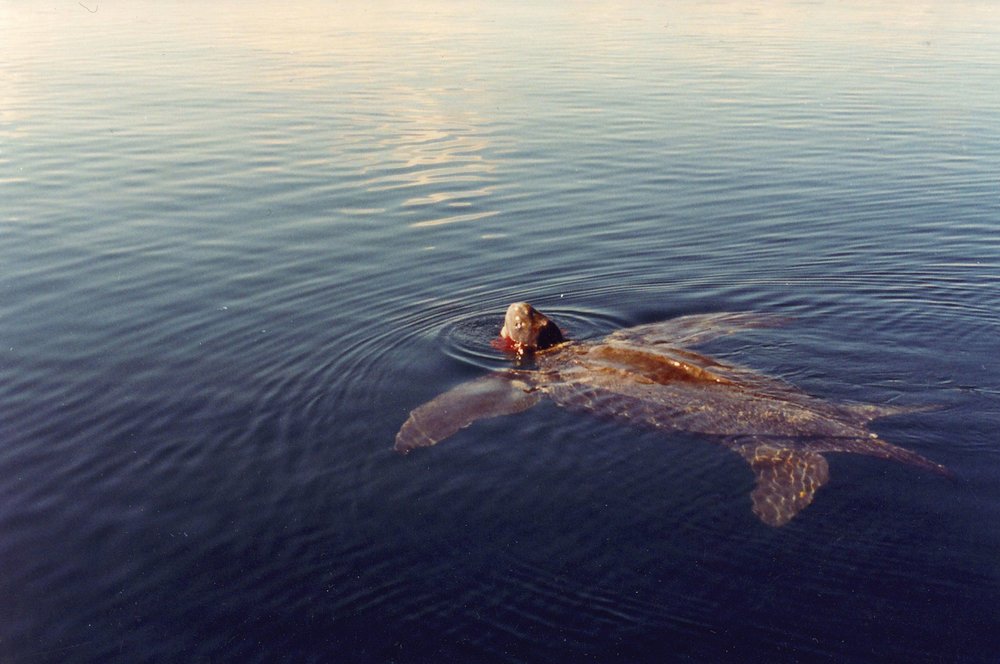The Mystery of Their Purpose: What are the ecological roles of sea turtles, and how many turtles are needed to fulfill those roles?
By Milani Chaloupka
A leatherback sea turtle feeds on a Cyanea species of jellyfish in the Trinity Bay area of Newfoundland, Canada. © CANADIAN SEA TURTLE NETWORK
Nature is a wise organizer. After 100 million years of survival and co-evolution, marine turtles surely play critical roles in coastal and oceanic ecology. But what are those roles, and how important are turtles in ecosystem services and functions? Are marine turtle populations regulated more by food availability or by predation? And given that sea turtles have been seriously depleted over the past four centuries, have their ecological roles changed? Most important, what would happen to Earth (ecologically speaking) if sea turtles were to disappear? Challenging questions such as these make ecological roles one of the great unsolved mysteries of marine turtle natural history.
Marine turtles are found in habitats from the shores to the abyss, and they range in their oceanic movements from the tropics to polar waters. They are a food source for marine, terrestrial, and airborne predators and even for some people. They are major consumers of sea life, and their lifestyles and waste products make them ecosystem engineers through their effects on coral reefs, seagrass pastures, sea bottom habitats, and possibly oceanographic forces. Their reproductive routines make sea turtles a dynamic link between land and sea, resulting in the transfer of vast amounts of energy and matter from the oceans to the nesting beaches that affect the ecology of terrestrial consumers from raccoons to soil microbes.
Marine turtles are major consumers, spanning several levels in the food web (see figure above). The green turtle is the most abundant of marine megaherbivores, consuming countless tons of seagrasses and algae. Similarly, the hawksbill is an abundant spongivore on coral reefs, while leatherbacks focus on gelatinous zooplankton. Olive Ridleys, Kemp’s Ridleys, flatbacks, and loggerheads consume vast amounts of invertebrates, from crustaceans to conch shells. However, consumption rates are not well known for marine turtles, and we are unsure what effect the historic depletion of turtles has had on marine food webs and ecosystem functions. Moreover, functional predator–prey responses remain a mystery for sea turtles, and we cannot estimate the extent of prey switching when preferred prey is depleted. An understanding of these and other variables will be necessary before we can develop meaningful models of the ecological role of marine turtles today and in the past.
In addition to what they consume, marine turtles also transfer nutrients and energy from the ocean to the land at nesting beaches when they deposit their eggs, and they are bioturbators, affecting the structure and functioning of foraging habitats such as coral reefs, seagrass meadows, algal beds, and soft substrate sea bottom. This ecosystem engineering contributes to nutrient recycling, as do the vast amounts of waste excreted from millions of turtles worldwide. Leatherbacks, which spend most of their lives in the oceanic habitat, and loggerheads, which aggregate in pelagic productivity hotspots, likely affect even long-term oceanographic patterns. Furthermore, marine turtles are important hosts for parasites and pathogens and are dispersal platforms for a vast range of epibionts, including barnacles, tunicates, and mollusks.
By themselves, the aforementioned observations of ecological functions and services tell us little about the effect marine turtles have on their habitats. Greater insights will derive from experimentation and ecosystem modeling and will require much more and better data than are currently available. In April 2006, a special session was held at the Annual Sea Turtle Symposium in Crete, Greece, with the purpose of addressing the gaps in our understanding of the ecological roles of marine turtles. The session brought together a range of people working on different facets of sea turtles’ ecological roles, and we are expecting exciting new developments in the months and years ahead as we struggle to unlock these mysteries.
This article originally appeared in SWOT Report, vol. 2 (2007). Click here to download the entire article as a PDF.

